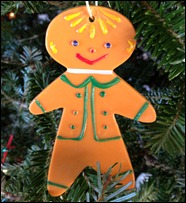Merry Christmas 2012
Posted By RichC on December 13, 2012
 Ah … we’re finished with this year’s Corbett Christmas Letter … they are in the mail! (click for a PDF copy)
Ah … we’re finished with this year’s Corbett Christmas Letter … they are in the mail! (click for a PDF copy)
One of my favorite things about celebrating Christmas is the reminiscing — especially when putting up, or just looking at, the decorated tree in our house. We have a mish-mash Christmas tree with decorations from all phases of our lives. There are “Baby’s First Christmas” and memento ornaments as well as photos  of Katelyn and Taylor ornaments and homemade hanging “things.” A couple cute school project items and even one from my past: a simple plastic gingerbread man. He has hung on every tree I can remember since I was a little boy. It is not the fanciest of ornaments or even one of any value to anyone but me … but this little guy triggers fond memories. (I plan on adding a few photos or some video to this QR Coded post after Christmas, so check back!)
of Katelyn and Taylor ornaments and homemade hanging “things.” A couple cute school project items and even one from my past: a simple plastic gingerbread man. He has hung on every tree I can remember since I was a little boy. It is not the fanciest of ornaments or even one of any value to anyone but me … but this little guy triggers fond memories. (I plan on adding a few photos or some video to this QR Coded post after Christmas, so check back!)
EDIT – added a few family Christmas related links:
- Katelyn had a bridal shower in Toledo (12/15)
- Mom Corbett passes away peacefully (12/17)
- Returning to normal after the funeral (12/21)
- Our Christmas Tree (12/24)
- Catering Christmas dinner to Columbus (12/25)
- Celebrating our later than usual family Christmas (12/30)
Along with gingerbread ornaments we also hung candy canes on the tree … who didn’t? According to The World of Christmas, the candy cane and its J-shape has an interesting story.
It is widely believed that the candy, which earlier was straight as a stick, was given its distinctive J-shape by a German choirmaster. It is said that during service one evening, the children were being very loud and noisy, creating quite a ruckus and not paying any attention to the choirmaster. To keep them quiet and still for the nativity ceremony, he gave them a long, white, sugar candy stick. Since giving chocolates and candies at church was considered sacrilegious, he bent these sticks at one end to make them look like a shepherd’s cane and thus, attached a religious significance to them. In Christianity, Jesus is regarded as the Good Shepherd and so, the staff is considered to be a sacred symbol. The Staff also represents the shepherds who came to visit the infant Jesus.
The candy cane became popular when, in 1847, a German-Swedish immigrant in Wooster, Ohio, who liked candy canes a lot, decided to string them on his Christmas tree as decorations. The idea soon caught up became quite a fashion in no time. By 1900, candy canes, which were earlier only white, came in red stripes, and with peppermint and cinnamon flavoring. Of course, now it’s a popular tradition everywhere.
The candy canes became a much sought-after Christmas-decoration item as the ‘hook’ in the candy made it easier to hang them on the Yule trees, and the unique shape made it an eye-catching attraction.
Symbolism
Traditionally, the only symbolism that was associated with the candy was that of the shepherd’s staff. But now, there is a modern allegorical interpretation of the candy cane. It is said that since the candy cane, when inverted, becomes J-shaped, it is a direct representation of Jesus Christ. The white color of the candy denotes the purity of Christ while the stripes represent His sacrifice and the whipping he received at the hands of the Romans, the color red symbolizing his blood. It is believed that even the peppermint flavor of the candy is so because it is similar to hyssop which, according to the Old Testament, symbolizes purification and sacrifice.

Comments